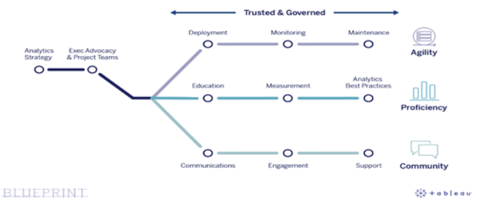How to create a solid data strategy in 8 key steps
Date: Thursday, February 2, 2023
“Data driven decision making (DDDM) is the process of using data to make informed and verified decisions to drive business growth. By using the right KPIs and tools and adhering to a clear process, companies can overcome biases and make the best managerial rulings that are aligned with their strategies”.
We find the majority of organisations are undervaluing the data they hold and need to be able to turn this into management information.
There has been a fundamental shift in recent years when it comes to how businesses think about and use data – from isolated and project-orientated data usage to a completely data-driven culture across an organisation. Business Intelligence is realised when everyone in the organisations has easy access to data-insights that are relevant to them and help them make better, more informed decisions.
In this blog post, we’ll explore how to create a solid data strategy in 8 key steps. With the right guidance and support, you can create an effective data strategy for your business that will give you a competitive edge and help you make more informed decisions.

1. Align your vision with your organisation’s goals
Having a vision that is aligned with your organisation’s goals is essential for success. On average, organisations that have an aligned vision are more successful, with higher employee engagement and customer satisfaction. Moreover, organisations that align their visions are more likely to achieve their goals and better able to adapt to changing environments. When creating an effective data strategy, aligning your vision with the organisation’s objectives is the first step.
The best way to do this is to understand how data can help the organisation achieve its goals and develop a strategy to ensure that the right data is being used effectively.
2. Choose the right architecture and tools
Organisations need to be able to turn their data into management information, and in the last two to three years, the focus of a Business Intelligence (BI) strategy has changed. Instead of focusing on the solution design first, businesses should first focus on their analytics strategy.

It is important to note that the analytics strategy should not be done in isolation. Each department should contribute to the process so that the strategy can be built around the requirements of each department. The Blueprint for Creating a Data-driven Organisation, created by Tableau, is a great framework for creating a solid data strategy. It provides guidance on software selection, governance structures, and more. With this in mind, organisations can make sure they have the right architecture and tools in place to best leverage their data.

3. Audit existing data assets
When building a data strategy, it is important to audit your existing data assets in order to determine their accuracy, breadth, and consistency. As part of this process, start by asking team leads or send out a survey to determine who is using customer experience (CX)-relevant data. This will help you identify key stakeholders who should be involved in the data audit process.
Once you have identified stakeholders, evaluate the data for accuracy, breadth, and consistency. During the evaluation process, look for recurring errors, formatting or structuring issues, gaps, or methodological problems. Using accuracy, breadth, and consistency as core values to weigh data against will help you make better decisions about your data strategy.
To ensure that data accuracy, breadth, and consistency are maintained over time, consider using software solutions to help. There are many software options available on the market today that can help automate processes and improve the accuracy, breadth, and consistency of your data. Choose a solution that works best for your business needs.
4. Data governance
Data governance is a critical element of any successful data strategy. It covers everything done to ensure that data is secure, private, accurate, available, and usable. It involves setting internal standards (data policies) that apply to how data is gathered, stored, processed, and disposed of. Additionally, data governance involves complying with external standards set by industry associations, government agencies, and other stakeholders.
The data governance framework defines the actions people must take, the processes they must follow, and the technology that supports them throughout the data life cycle. This includes rules and roles related to who has access to data and how it is used. Data governance should also include processes for storing, maintaining, and disposing of data in a secure manner. Data stewardship ensures the accuracy and completeness of data, as well as the integrity of metadata. Finally, effective data governance requires oversight and accountability for compliance with applicable laws and regulations.
5. Define roles and responsibilities
Creating a data management team is essential to formulating and executing a solid data strategy. This team should include senior-level managers, department heads, and other personnel with diverse perspectives and experience in the company. An assessment of in-house talent should be conducted, and if needed, outside resources should be hired to fill any gaps. This team will be responsible for allocating resources, developing and improving policies, and dealing with any data-related issues that arise.
By assigning data governance roles to individual members of the team, it can help ensure that the necessary tasks get done and promote a sense of ownership. This could include roles such as: data stewardship, data quality assurance, data analysis, security, privacy, and archiving. Having clearly defined roles and responsibilities ensures that everyone is on the same page when it comes to the data strategy, which is key to its successful implementation.
6. Create a training plan
Having a solid training plan is essential for the success of your data strategy. It is important to ensure that everyone in your organisation understands what the strategy entails and how it can benefit the company. Training employees on the data strategy will help them better understand how to work with the data, how to make decisions using data, and how to use analytics tools to gain insights from the data.
The training should also include information on data governance and security practices so that all staff are aware of their responsibilities when working with data. This will help ensure that data is kept safe and secure, as well as ensuring that the quality and accuracy of the data remains high. By training staff on the data strategy, your organisation will be able to achieve its goals faster and more efficiently.
7. Create a roadmap visualisation
Creating a roadmap visualisation is an important step to ensure success in executing your data strategy. A roadmap is a diagram or chart that outlines a timeline for the delivery of your data projects. It gives an overview of which tasks and initiatives should be completed and when, enabling you to identify dependencies, evaluate risks, and plan resources.
When creating your roadmap, consider all stakeholders and their needs. This will help you identify the actions and goals necessary for successful implementation. Additionally, consider timelines, budget and potential risks associated with each action item. When you have a clear understanding of these elements, you can create a timeline for completion of each action item, as well as a timeline for achieving the entire data strategy.
Finally, once the roadmap is complete, use it as a tool to communicate your plans to all stakeholders. Make sure to review it regularly to adjust it if needed in order to stay on track.
By creating a roadmap visualisation, you can ensure the successful implementation of your data strategy. This visual representation of your data projects and initiatives will help you effectively manage and deliver on your data goals.
8. Be realistic - don't try to do everything at once!
Creating a solid data strategy can feel like a daunting task, but it is important to remember that you should take it one step at a time. Trying to do everything at once will only lead to frustration and can set you up for failure. Instead, take a systematic approach and break your goals into achievable pieces. Map out each step of your strategy and create timelines so that you can move through each element in an organised manner. With realistic expectations, you can stay on track and avoid becoming overwhelmed.
Further help
Village Software deliver a Full day session to help organisations plan their Analytics Strategy. Using the Village BI strategy framework this session is designed to help you:
· Identify key department advocates and sponsors.
· Identify key analytics requirements for each part of your business.
· Ascertain the required data sources.
· Agree the solutions architecture.
· Agree key people as well as in-house and Village resource input style.
· Agree next steps.
Please get in touch for further information.
Other related resources
· GUIDE DOWNLOAD: Business Intelligence for Business Leaders: overcoming everyday data issues which you are able to download here.
· For further blogs and insights please visit our website.
About Village Software
Village Software Engineering design and build incredible software solutions with the single aim of improving your business.
We specialise in Data Analytics & BI, Bespoke Software, and Enterprise Integration. Our team of innovative and skilled developers work across many sectors including manufacturing, education, transportation and logistics, healthcare, utilities and retail.
Leaders in our field, we provide application development, enterprise integration and business intelligence software solutions that embrace leading edge technologies and methods.
Our curiosity and intelligent thinking help us to deliver quality solutions that don’t just work but work for you.
 About Us
About Us Services
Services Sectors
Sectors Case Studies
Case Studies Blog
Blog Contact
Contact


